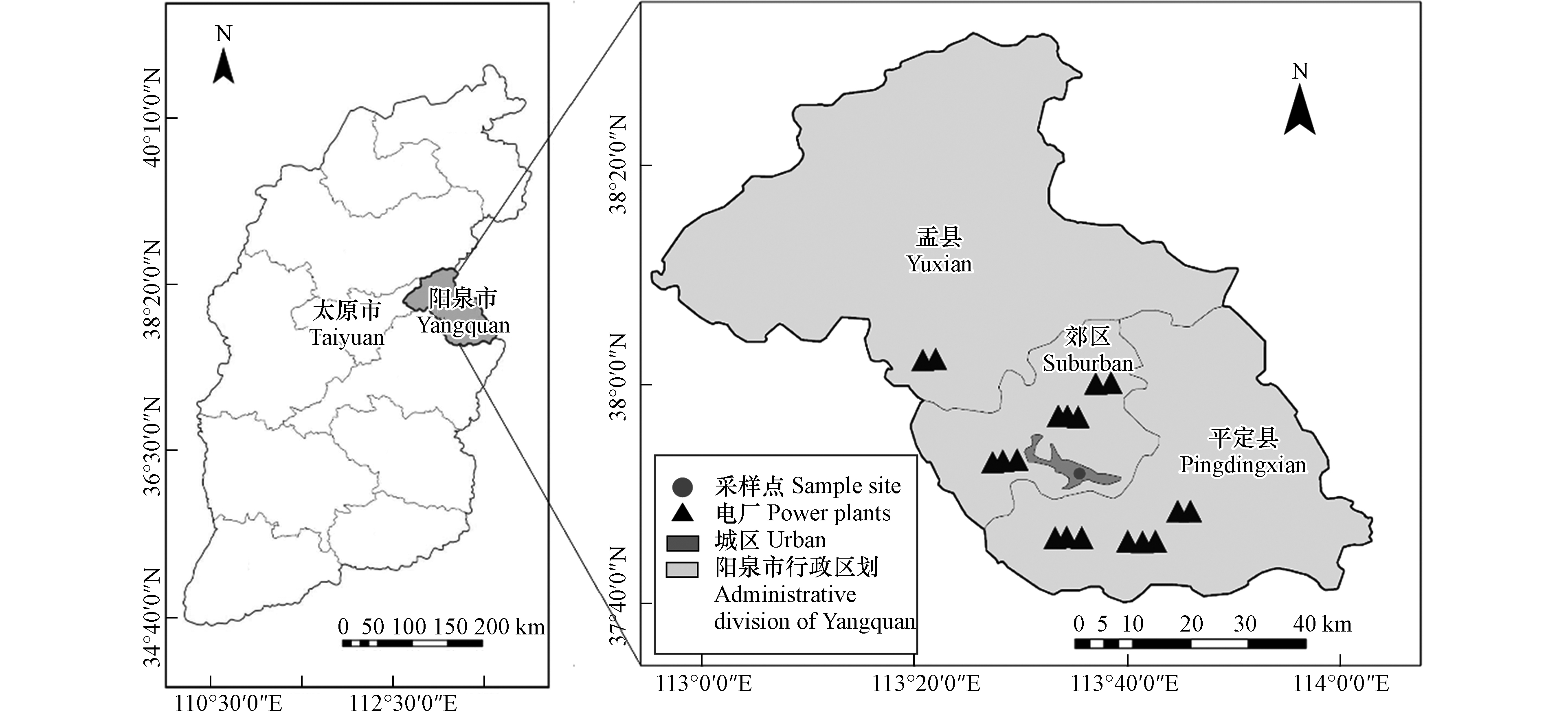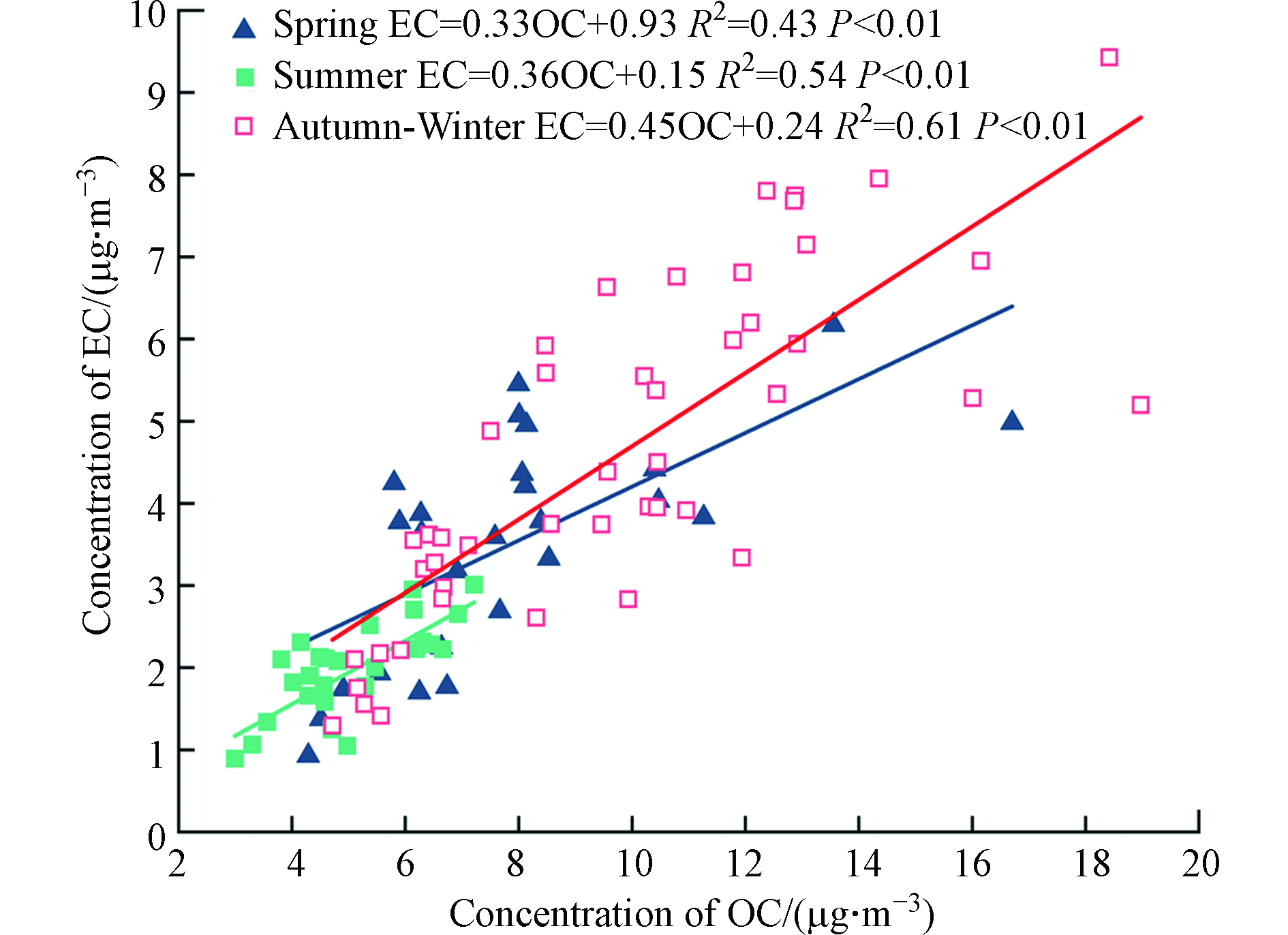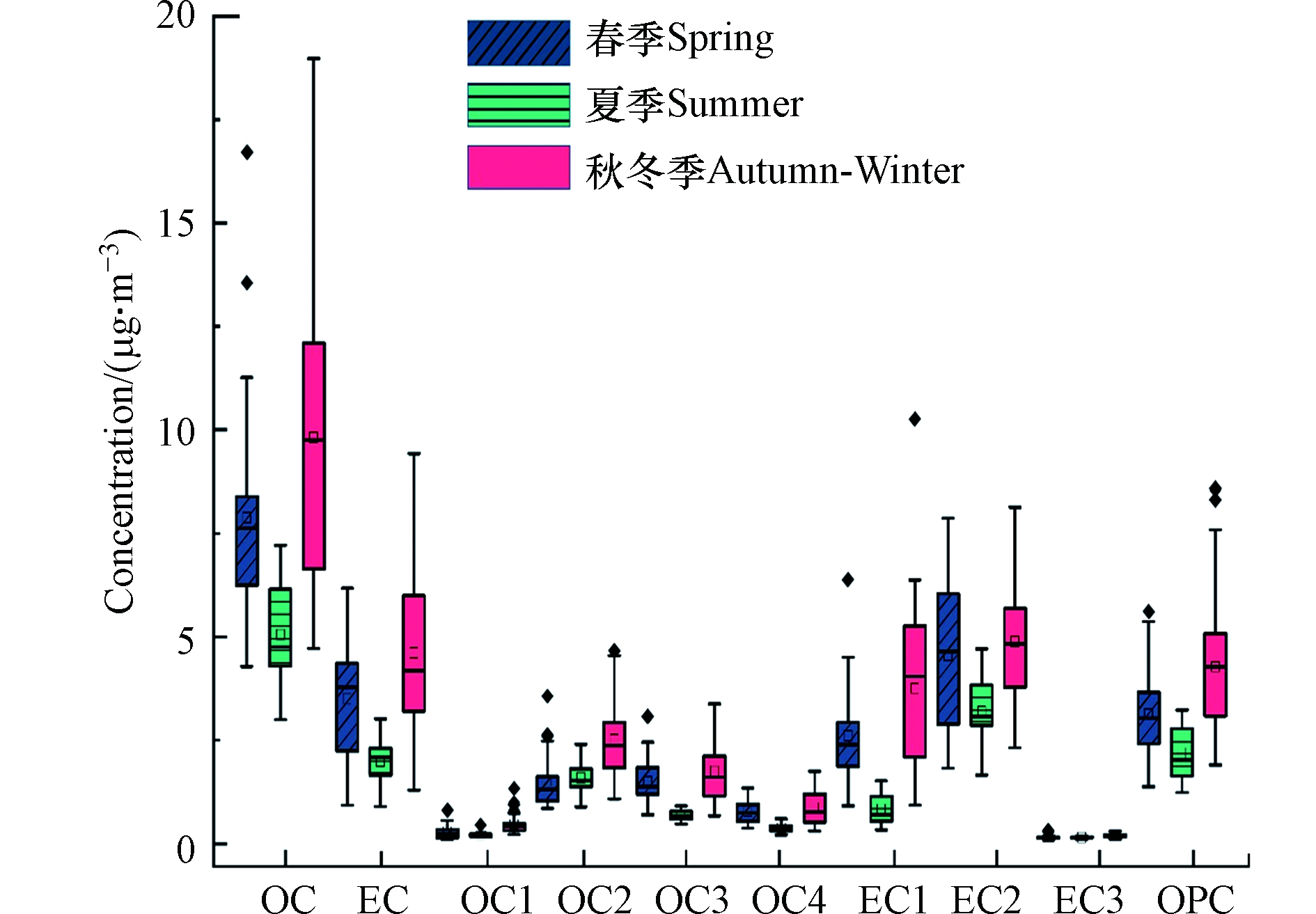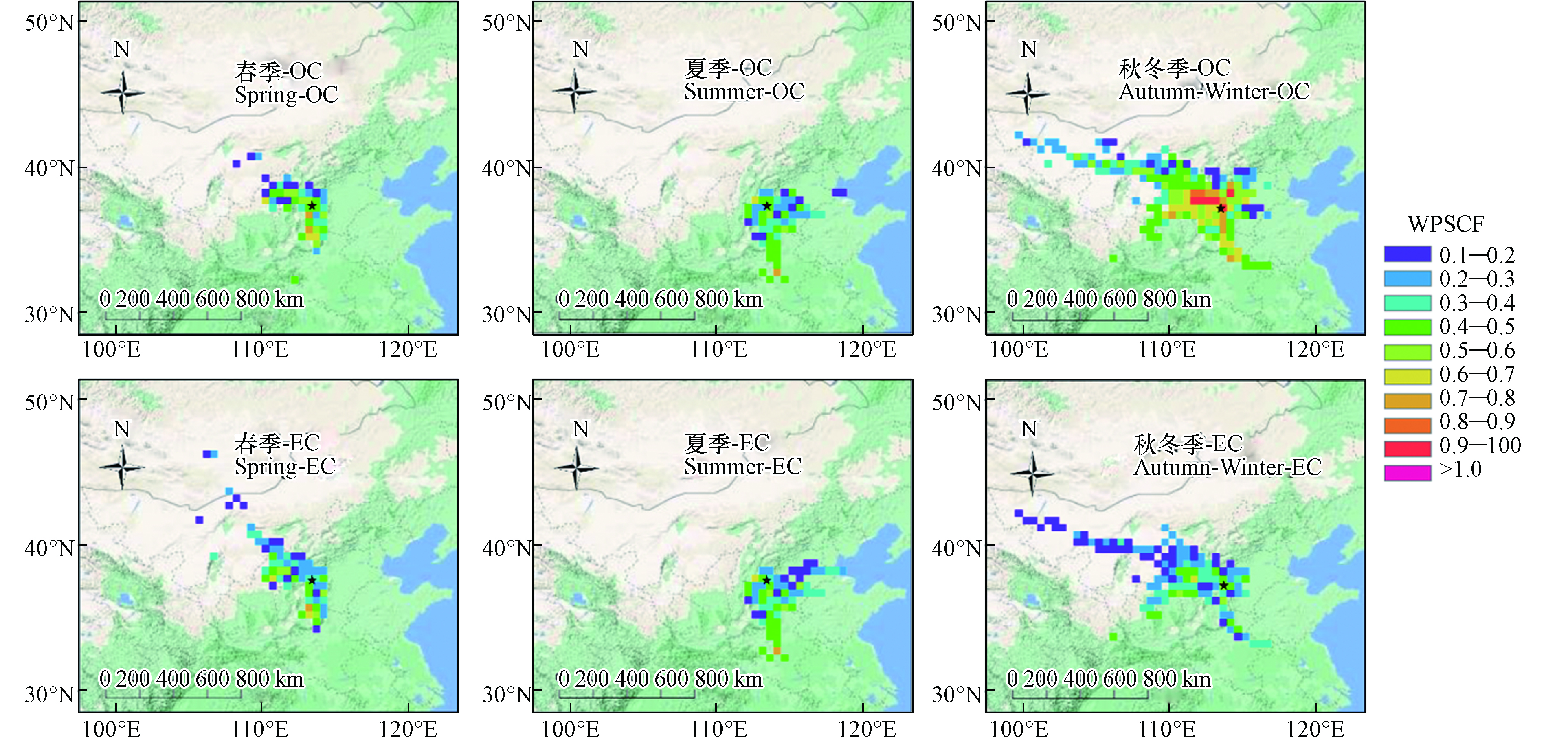-
大气细颗粒物 (PM2.5)是影响我国大多数城市空气质量的主要污染物[1-2]。碳质气溶胶是PM2.5的重要组成部分,主要组分包括有机碳(OC)和元素碳(EC),约占PM2.5质量的20%—70%[3-5]。OC来源复杂,除污染源(如机动车、化石燃料、生物质燃烧等)直接排放的一次有机碳(POC)外,还有来自光化学反应生成的二次有机碳(SOC)[6];EC主要来自化石燃料和生物质的不完全燃烧[7]。研究表明,碳质气溶胶对能见度、空气质量和区域气候都有很大影响[8-9]。因此,研究碳质气溶胶的污染特征及来源对有效控制碳质颗粒物至关重要。
近年来,研究学者对PM2.5中OC、EC进行了大量研究,探讨了含碳质组分的浓度水平、季节分布以及污染来源等特征。如张婷婷等[10]对北京市城区碳质组分分析发现,OC在PM2.5中所占比例(13%)大于EC(5%),二者季节变化特征均为冬季最高,夏季最低。程渊等[11]发现SOC为天津市夏季和冬季碳质组分中重要组成部分,在OC中占比分别为34%和27%。张懿华等[12]对上海城区碳质组分进行分析,发现燃煤源、机动车排放、扬尘源和生物质燃烧源是OC、EC的主要来源。董贵明等[13]使用潜在源贡献因子法分析发现,西南部的山西省和河南省部分地区是北京市大气PM2.5中OC的主要潜在源区,南部的山东省和河南省部分地区是EC的主要潜在源区。目前,对碳质气溶胶的研究主要集中在京津冀、长三角、珠三角及关中地区等城市[11,14-15],为颗粒物中碳质气溶胶污染防治提供了重要的研究基础。
阳泉市位于山西省东部,是京津冀大气污染传输通道“2+26”城市之一。电力、煤炭、水泥、有色金属冶炼及加工等是阳泉市主导产业,经济结构整体偏重,再加上近些年机动车保有量逐年上升,导致阳泉市大气颗粒物污染问题日益突出,阳泉市2018年全年污染天数120 d,占比达33.0%,PM2.5浓度为59 μg·m−3是国家Ⅱ类标准限值[16](35 μg·m−3) 的1.7倍.已有的研究包括利用空气质量模式对阳泉市重污染过程中PM2.5的来源进行分析,利用受体模型对阳泉市秋冬季PM2.5化学组分及来源分析等[17-18],但鲜有文献对阳泉市不同季节PM2.5中碳质气溶胶进行研究。
本研究以阳泉市城区为研究对象,对2018年7月—2019年4月PM2.5样品中OC和EC组分含量进行分析,使用最小相关系数法(MRS)估算了SOC的浓度,并利用比值分析、相关性分析及潜在源贡献因子分析(PSCF)研究了PM2.5中碳质气溶胶的来源,以期为阳泉市颗粒物污染防治提供方向。
-
阳泉市是典型的山地型城市(“两山夹一谷”),属暖温带半干旱大陆性季风气候。本研究采样点(113.61°E,37.85°N)位于阳泉市文化宫3层楼顶平台,距地面约11 m,为教育、住宅、商业混合区,附近无明显排放源(图1).
PM2.5样品采集时间为2018年7月2日至2018年7月31日、2018年10月15日至11月30日和2019年3月1日至2019年3月31日,分别代表夏季、秋冬季和春季,样本数分别为26、46和26。采样期间每天10:00至次日09:00使用多通道采样器(TH-16A,武汉天虹仪表有限公司)采集PM2.5样品,采样器流量为16.7 L·min−1。选择直径为47 mm的石英滤膜进行PM2.5的采集,并用于分析碳质组分。
气象参数(风速、湿度和温度)和气态污染物(SO2、NO2、CO和O3-8H)来自中国环境监测总站的“全国城市空气质量实时发布平台”[19]。
-
使用美国Sunset实验室研发的Model 5L OC/EC热光碳分析仪对样品中的OC、EC进行分析测定,主要分析原理是IMPROVE热光反射法[20],即使用程序升温,分2个阶段:第1阶段为纯氦环境下升温,分别在140、280、480、580 ℃条件下得到OC1、OC2、OC3、OC4这4种亚组分,第2阶段为在有氧环境(2%氧+98%氦)下升温,分别在580、740、840 ℃条件下得到EC1、EC2、EC3的3种亚组分。升温全程采用633 nm激光照射样品,测定有机碳碳化形成的裂解碳(OPC),最终定义:
-
石英滤膜在使用前先在450 ℃下燃烧4 h,除去滤膜中残留碳及其他杂质。采样前后滤膜置于恒温恒湿箱(温度22 ℃、相对湿度40%)内平衡24 h后,在电子天平室进行称重(检测限是1 μg),最后将滤膜用铝箔纸包好保存在−20 ℃的冰箱。采样期间,定期对相关配件和耗材进行更换,以及对采样器进行校准;每批次样品分析时,采用CH4/He 标准气体对仪器进行校正,相对标准偏差不超过5%,每次10%样品进行重复分析。
-
通过计算污染轨迹与所有轨迹在途径区域中的停留时间之比来解析每个网格对受点区域污染的贡献。将所选研究区域划分为i×j个网格,mij为经过这些网格的污染轨迹数,nij为所有轨迹数量,本研究设定的污染阈值为各季节各污染物70%分位数浓度水平,PSCF计算公式为:
由于PSCF是一种条件概率函数,当nij较小时,会增加结果的不确定性。为降低这种误差,引入权重函数Wij,即WPSCF=Wij×PSCF。当某个网格中的nij小于研究区域内每个网格平均轨迹数的3倍时,需要引入Wij来降低PSCF的不确定性。WPSCF值越大,表明此区域对受点的质量浓度贡献越大。
-
如表1所示,采样期间阳泉市ρ(PM2.5)为(69.4±26.6) μg·m−3 (19.5—252.5 μg·m−3),是GB3095—2012 Ⅱ类标准年均限值[16](35 μg·m−3)的2.0倍,是世界卫生组织(WHO)环境空气指导值[21](10 μg·m−3)的6.9倍,表明阳泉市细颗粒物污染较为严重。采样期间ρ(PM2.5)的季节变化明显,主要表现为春季((81.8±28.4)μg·m−3) >秋冬季((74.0±28.6)μg·m−3) >夏季((48.6±11.7)μg·m−3)。分析发现ρ(PM2.5)的季节变化主要是受到污染源和气象因素的双重影响。秋冬季与春季观测期间PM2.5浓度因受采暖期(2018年11月1至2019年3月31日)燃煤及生物质燃烧的影响而高于夏季PM2.5浓度。春季低湿度(47%,显著低于其他季节)和高风速(1.4 m·s−1,显著高于其他季节)使颗粒物再次悬浮,导致春季ρ(PM2.5)高于秋冬季(表1)。夏季ρ(PM2.5)最低是由于空气对流增强以及降雨较其他季节多。
总碳气溶胶(TCA)指气溶胶中的含碳组分,可反映区域碳质气溶胶的污染严重程度[22],通常计算方法为有机物(OM=1.6×OC)和EC的质量浓度之和[23],即TCA=OM+EC。采样期间TCA浓度为16.4 μg·m−3,在PM2.5中的占比为23.6%,高于太原[15](20%)和广州[14](22%),低于北京[13](25%)、天津[11](27%)、武汉[24](27%)、菏泽[25](25%)等城市(表2)。说明阳泉市碳质气溶胶污染处于中等水平。
采样期间OC、EC的平均浓度分别为(8.0±2.8) μg·m−3和(3.6±1.5) μg·m−3,均呈秋冬季((9.8±2.9)μg·m−3、(4.6±1.7) μg·m−3)>春季((7.9±1.9)μg·m−3、(3.5±1.1) μg·m−3)>夏季((5.1±1.0)μg·m−3、(2.0±0.4 μg·m−3),季节性变化趋势与ρ(PM2.5)不同。春季和夏季OC、EC在PM2.5中的占比均明显低于秋冬季(表1)。分析发现,虽然秋冬季与春季均受到燃煤源的影响,但春季碳含量相对较低的扬尘、矿物质等组分对ρ(PM2.5)的贡献高于冬季[17],最终导致出现春季ρ(PM2.5)高于秋冬季,而秋冬季OC、EC浓度及其在PM2.5中占比却高于春季的现象. EC在PM2.5中占比与其浓度的季节变化一致,即秋冬季(6.2%)>春季(4.3%)>夏季(4.1%)(表1),这一结果与纪尚平等[26]2015和2017年在邯郸市的研究结果一致。
-
目前技术还难以直接区分气溶胶中一次有机物(POC)和SOC[27]。最常用的SOC计算方法是EC示踪法,计算公式[23]为:
式中,SOC为估算的二次有机碳质量浓度,µg·m−3;(OC/EC)pri为一次排放到大气中的OC/EC比值.
EC示踪法的关键是确定(OC/EC)pri的值,本研究使用最小相关系数法(MRS,Minimum R Squired)来确定(OC/EC)pri比率[28]。MRS通过计算一组假设的(OC/EC)pri和SOC值得到(OC/EC)pri,产生最小R2 (SOC,EC)的(OC/EC)pri即为实际的(OC/EC)pri比率[29]。结果显示春季、夏季和秋冬季(OC/EC)pri的值分别为1.37,1.53和1.39 (图2)。
如表3所示,采样期间SOC的平均浓度为(3.0±1.4) µg·m−3,在OC中占比达到38%,说明SOC是阳泉市PM2.5中OC的重要组成部分. SOC浓度季节变化趋势为秋冬季((3.4±1.6) µg·m−3)>春季((3.2±1.4)µg·m−3)>夏季((2.0±0.7)µg·m−3),SOC浓度的季节变化趋势与OC、EC浓度季节变化特征一致,但与SOC/OC的季节变化不同,春季和夏季的SOC/OC值均为40%,均高于秋冬季(35%)。春季SOC/OC值较高,是由于阳泉春季的风速较大且湿度较低,同时城市周边存在大量裸露的山地,极容易发生扬尘天气,扬尘的碱性特征有利于酸性气体的吸附和异相反应,发生了扬尘和有机物耦合反应,促进了二次有机物的转化[30-32]。相比于其他季节,夏季气温较高 (26 ℃),湿度大 (88%),有利于挥发性、半挥发性有机物等前体物的光化学反应生成 SOC[33]。秋冬季SOC/OC值较低,与秋冬季温度低导致SOC前体物的转化率下降有关[9]。
-
不同污染源排放的碳质气溶胶中OC/EC比值不同,因此可以采用OC/EC来定性确定碳质气溶胶的来源。典型污染源包括燃煤(OC/EC=2.5—10.5)[34]、机动车尾气(OC/EC=1.0—4.2)[35]和生物质燃烧(OC/EC=16.8—40.0)[36]。阳泉市采样期间OC/EC在1.4—4.8之间,春季、夏季和秋冬季OC/EC分别为2.5、2.6和2.3,说明采样期间各季节PM2.5中碳质气溶胶的主要来源可能是燃煤源和机动车尾气。
有研究表明,通过OC和EC之间的相关性,可以初步判断二者是否都具有同源性[29]。若OC和EC的相关性较好,说明二者具有相似的来源,反之,说明二者可能来源差异较大或具有二次污染[23,37]. OC与EC在夏季、春季和秋冬季均呈弱相关(图3),R2分别为0.54,0.43和0.61,这表明阳泉市的碳质气溶胶来源较为复杂,受到多种排放源和大气化学转化过程的影响。
-
研究表明[38-39],城市环境大气中SO2主要来源于燃煤排放,而CO和NO2主要来源于机动车尾气排放,O3和SOC主要是由光化学反应产生。因此,通过分析碳质组分与气态污染物之间的相关性,可定性地判断碳质组分的形成和来源。从全年来看,OC和EC与气态污染物SO2、NO2和CO均呈显著正相关,说明阳泉市碳质气溶胶可能受到机动车尾气和燃煤源的影响(表4)。从季节变化来看,夏季、秋冬季和春季PM2.5中OC和EC与SO2、NO2和CO均呈显著正相关,表明燃煤源和机动车尾气对各季节碳质组分的影响都比较大。夏季和春季OC和SOC与O3均呈正相关,尤其是夏季(0.731和0.657,P<0.01),而秋冬季OC和SOC与O3呈负相关(表4)。夏季和春季的日均O3浓度(111 µg·m−3和62 µg·m−3)明显高于秋冬季(33 µg·m−3),说明夏季和春季大气氧化作用强,加快污染物光化学反应的进行,促进SOC和O3的形成,而秋冬季由于光照时间短,大气氧化能力弱,污染天气频发,能见度下降,不利于光化学反应的进行,这与前文对SOC的研究结果一致,即秋冬季OC中SOC的占比低于春季和夏季。
-
源谱研究[10,40-41]发现,不同污染源源排放的碳质亚组分组成都有一定的差异,可以分析碳质气溶胶的来源[15]。其中,OC1主要是生物质燃烧排放的碳质组分,OC2是燃煤排放的标识组分,OC3和OC4是道路扬尘中丰富的碳质组分,EC1在汽油车尾气中的含量较高,EC2和EC3在柴油车尾气中的含量较高.如图4为不同季节8种碳亚组分的浓度,与OC、EC的季节变化规律一致,均呈秋冬季>春季>夏季。同时,各季节碳质组分浓度排序基本一致,均呈现EC2、OPC、EC1和OC2浓度最高,OC3和OC4居中,OC1和EC1最小的趋势。各季节EC2、EC1和OC2等亚组分的浓度之和在总碳(TC)中的占比在春季、夏季和秋冬季分别达到76%、79%和77%,表明阳泉市各季节碳质气溶胶主要来源于机动车尾气和燃煤源,这与OC/EC比值法以及碳质气溶胶与气态污染物相关性分析的污染来源一致。此外,各季节OC3、OC4浓度在TC中占比均超过15%,说明扬尘源对阳泉市碳质气溶胶的贡献也不容忽视。春季和秋冬季OC3、OC4浓度之和在TC中占比分别为20%和18%,明显高于夏季(15%),说明春季和秋冬季扬尘源对碳质气溶胶的贡献高于夏季。
-
采样期间碳质组分PSCF分析结果如图5所示。整体来看,碳质组分除受到本地排放的影响之外,秋冬季和春季OC受到周边区域的影响较大,EC受到远距离传输的影响较大,而夏季OC、EC均受到近距离的影响。
夏季OC、EC的潜在源区分布在阳泉市南部和东部方向的区域范围内,WPSCF 值均处于较低水平,该区域传输影响较弱。春季OC、EC的潜在源区主要分布在阳泉市西部和南部方向的区域内,同时EC也受到阳泉市西北方向的内蒙古和蒙古国部分地区的远距离传输的影响。春季OC、EC的WPSCF高值(>0.6)[42-43]主要出现在阳泉市西部方向的山西省中部地区和南部方向的山西省东南部地区。山西省中部和东南部都是重要的煤炭生产和使用地区,其排放的污染物对于阳泉市碳质气溶胶的影响较大。秋冬季OC、EC的潜在源区在阳泉市各方向上均有分布,在西北和东南方向分别最远延伸至内蒙古西部和河南省的东部地区。相比于EC,秋冬季OC受到本地以及周边区域的影响明显增加,WPSCF高值(>0.6)分布较为集中,分布在山西省以及河南省和河北省的部分地区,形成了一个WPSCF高值带。
-
(1) 采样期间ρ(PM2.5)为(69.4±26.6) μg·m−3,其中春季ρ(PM2.5)为(81.8±28.4) μg·m−3,高于夏季和秋冬季(48.6±11.7)μg·m−3和(74.0±28.6) μg·m−3。OC、EC的浓度分别为(8.0±2.8)μg·m−3和(3.6±1.5) μg·m−3,季节性变化趋势均呈秋冬季>春季>夏季。
(2) PM2.5中SOC的平均浓度为(3.0±1.4) µg·m−3,在OC中为38%,在春季和夏季的占比(40%)高于秋冬季(35%)。OC、EC与气态污染物SO2、NO2和CO均显著相关,表明燃煤源和机动车尾气对碳质组分的影响较大。
(3) 各季节碳质亚组分分析显示PM2.5中碳质气溶胶主要来源于机动车尾气、燃煤源和扬尘源,其中扬尘对春季和秋冬季碳质气溶胶的贡献高于夏季。
(4) PSCF分析表明,碳质组分除受到本地排放的影响之外,秋冬季和春季的OC受到周边区域的影响较大,EC受到远距离传输的影响较大,而夏季OC、EC均受到近距离的影响。
阳泉市PM2.5中碳质气溶胶污染特征及来源分析
Pollution characteristics and sources analysis of carbonaceous aerosols in PM2.5 in Yangquan
-
摘要: 采集了阳泉市城区2018年7月—2019年3月PM2.5样品,分析了样品中有机碳(OC)和元素碳(EC)组分含量,使用最小相关系数法估算了二次有机碳(SOC)的浓度,并利用比值分析、相关性分析及潜在源贡献因子等方法研究了PM2.5中碳质气溶胶的来源。结果表明,采样期间ρ(PM2.5)为(69.4±26.6) μg·m−3,其中春季ρ(PM2.5)为(81.8±28.4) μg·m−3,高于夏季和秋冬季(48.6±11.7) μg·m−3和(74.0±28.6) μg·m−3。OC、EC的浓度分别为(8.0±2.8)、(3.6±1.5) μg·m−3,均呈秋冬季>春季>夏季的季节变化趋势. PM2.5中SOC的平均浓度为(3.0±1.4) µg·m−3,在OC中为38%,在春季和夏季的占比(40%)高于秋冬季(35%)。OC、EC与气态污染物SO2、NO2和CO均显著相关,表明燃煤源和机动车尾气对碳质组分的影响较大。各季节碳质亚组分分析显示PM2.5中碳质气溶胶主要来源于机动车尾气、燃煤源和扬尘源,其中扬尘对春季和秋冬季碳质气溶胶的贡献高于夏季。对潜在源区分析表明,碳质组分受到本地和近距离区域排放影响较大,秋冬季和春季的EC也受到远距离传输的较大影响。Abstract: PM2.5 samples were collected from July 2018 to March 2019 in the urban area of Yangquan, and the carbon component of organic carbon (OC) and elemental carbon (EC) in the PM2.5 samples were analyzed. The concentration of secondary organic carbon (SOC) was estimated by the minimum phase relation number method (MRS), and sources of carbonaceous aerosols in PM2.5 were conducted by ratio analysis, correlation analysis and potential source contribution factor analysis (PSCF). The results showed that the PM2.5 concentration during the sampling period was (69.4±26.6) μg·m−3, while the concentration of (81.8±28.4) μg·m−3 in the spring was higher than that in the summer ((48.6±11.7)μg·m−3) and autumn-winter ((74.0±28.6)μg·m−3). The concentrations of OC and EC were (8.0±2.8)μg·m−3 and (3.6±1.5) μg·m−3, respectively, with a seasonal trend of autumn-winter>spring>summer. The average SOC concentration was (3.0±1.4) μg·m−3, which accounted for 38% of OC. The proportions of SOC in OC were higher in the spring (40%) and summer (40%) than in the autumn-winter (35%). OC and EC were significantly correlated with gaseous pollutants of SO2, NO2, and CO, which indicated that coal combustion and vehicle emissions had a great influence on carbonaceous aerosols. The analysis of carbon subcomponents in each season showed that the main sources of carbonaceous aerosols in PM2.5 were vehicle emissions, coal combustion and dust, and the contribution of dust in the spring and autumn-winter was higher than that in the summer. Potential source contribution function (PSCF) analysis showed that the carbon components were strongly influenced by local and nearby area emissions, while the EC was also significantly affected by long-range transport in the spring and autumn-winter.
-
大气细颗粒物 (PM2.5)是影响我国大多数城市空气质量的主要污染物[1-2]。碳质气溶胶是PM2.5的重要组成部分,主要组分包括有机碳(OC)和元素碳(EC),约占PM2.5质量的20%—70%[3-5]。OC来源复杂,除污染源(如机动车、化石燃料、生物质燃烧等)直接排放的一次有机碳(POC)外,还有来自光化学反应生成的二次有机碳(SOC)[6];EC主要来自化石燃料和生物质的不完全燃烧[7]。研究表明,碳质气溶胶对能见度、空气质量和区域气候都有很大影响[8-9]。因此,研究碳质气溶胶的污染特征及来源对有效控制碳质颗粒物至关重要。
近年来,研究学者对PM2.5中OC、EC进行了大量研究,探讨了含碳质组分的浓度水平、季节分布以及污染来源等特征。如张婷婷等[10]对北京市城区碳质组分分析发现,OC在PM2.5中所占比例(13%)大于EC(5%),二者季节变化特征均为冬季最高,夏季最低。程渊等[11]发现SOC为天津市夏季和冬季碳质组分中重要组成部分,在OC中占比分别为34%和27%。张懿华等[12]对上海城区碳质组分进行分析,发现燃煤源、机动车排放、扬尘源和生物质燃烧源是OC、EC的主要来源。董贵明等[13]使用潜在源贡献因子法分析发现,西南部的山西省和河南省部分地区是北京市大气PM2.5中OC的主要潜在源区,南部的山东省和河南省部分地区是EC的主要潜在源区。目前,对碳质气溶胶的研究主要集中在京津冀、长三角、珠三角及关中地区等城市[11,14-15],为颗粒物中碳质气溶胶污染防治提供了重要的研究基础。
阳泉市位于山西省东部,是京津冀大气污染传输通道“2+26”城市之一。电力、煤炭、水泥、有色金属冶炼及加工等是阳泉市主导产业,经济结构整体偏重,再加上近些年机动车保有量逐年上升,导致阳泉市大气颗粒物污染问题日益突出,阳泉市2018年全年污染天数120 d,占比达33.0%,PM2.5浓度为59 μg·m−3是国家Ⅱ类标准限值[16](35 μg·m−3) 的1.7倍.已有的研究包括利用空气质量模式对阳泉市重污染过程中PM2.5的来源进行分析,利用受体模型对阳泉市秋冬季PM2.5化学组分及来源分析等[17-18],但鲜有文献对阳泉市不同季节PM2.5中碳质气溶胶进行研究。
本研究以阳泉市城区为研究对象,对2018年7月—2019年4月PM2.5样品中OC和EC组分含量进行分析,使用最小相关系数法(MRS)估算了SOC的浓度,并利用比值分析、相关性分析及潜在源贡献因子分析(PSCF)研究了PM2.5中碳质气溶胶的来源,以期为阳泉市颗粒物污染防治提供方向。
1. 材料与方法(Materials and methods)
1.1 样品采集
阳泉市是典型的山地型城市(“两山夹一谷”),属暖温带半干旱大陆性季风气候。本研究采样点(113.61°E,37.85°N)位于阳泉市文化宫3层楼顶平台,距地面约11 m,为教育、住宅、商业混合区,附近无明显排放源(图1).
PM2.5样品采集时间为2018年7月2日至2018年7月31日、2018年10月15日至11月30日和2019年3月1日至2019年3月31日,分别代表夏季、秋冬季和春季,样本数分别为26、46和26。采样期间每天10:00至次日09:00使用多通道采样器(TH-16A,武汉天虹仪表有限公司)采集PM2.5样品,采样器流量为16.7 L·min−1。选择直径为47 mm的石英滤膜进行PM2.5的采集,并用于分析碳质组分。
气象参数(风速、湿度和温度)和气态污染物(SO2、NO2、CO和O3-8H)来自中国环境监测总站的“全国城市空气质量实时发布平台”[19]。
1.2 化学分析方法
使用美国Sunset实验室研发的Model 5L OC/EC热光碳分析仪对样品中的OC、EC进行分析测定,主要分析原理是IMPROVE热光反射法[20],即使用程序升温,分2个阶段:第1阶段为纯氦环境下升温,分别在140、280、480、580 ℃条件下得到OC1、OC2、OC3、OC4这4种亚组分,第2阶段为在有氧环境(2%氧+98%氦)下升温,分别在580、740、840 ℃条件下得到EC1、EC2、EC3的3种亚组分。升温全程采用633 nm激光照射样品,测定有机碳碳化形成的裂解碳(OPC),最终定义:
OC=OC1+OC2+OC3+OC4+OPC (1) EC=EC1+EC2+EC3−OPC (2) 1.3 质量保证及控制
石英滤膜在使用前先在450 ℃下燃烧4 h,除去滤膜中残留碳及其他杂质。采样前后滤膜置于恒温恒湿箱(温度22 ℃、相对湿度40%)内平衡24 h后,在电子天平室进行称重(检测限是1 μg),最后将滤膜用铝箔纸包好保存在−20 ℃的冰箱。采样期间,定期对相关配件和耗材进行更换,以及对采样器进行校准;每批次样品分析时,采用CH4/He 标准气体对仪器进行校正,相对标准偏差不超过5%,每次10%样品进行重复分析。
1.4 潜在源贡献因子分析(PSCF)
通过计算污染轨迹与所有轨迹在途径区域中的停留时间之比来解析每个网格对受点区域污染的贡献。将所选研究区域划分为i×j个网格,mij为经过这些网格的污染轨迹数,nij为所有轨迹数量,本研究设定的污染阈值为各季节各污染物70%分位数浓度水平,PSCF计算公式为:
PSCFij=mij/nij (3) 由于PSCF是一种条件概率函数,当nij较小时,会增加结果的不确定性。为降低这种误差,引入权重函数Wij,即WPSCF=Wij×PSCF。当某个网格中的nij小于研究区域内每个网格平均轨迹数的3倍时,需要引入Wij来降低PSCF的不确定性。WPSCF值越大,表明此区域对受点的质量浓度贡献越大。
2. 结果与讨论(Results and discussion)
2.1 PM2.5及碳质气溶胶污染特征
如表1所示,采样期间阳泉市ρ(PM2.5)为(69.4±26.6) μg·m−3 (19.5—252.5 μg·m−3),是GB3095—2012 Ⅱ类标准年均限值[16](35 μg·m−3)的2.0倍,是世界卫生组织(WHO)环境空气指导值[21](10 μg·m−3)的6.9倍,表明阳泉市细颗粒物污染较为严重。采样期间ρ(PM2.5)的季节变化明显,主要表现为春季((81.8±28.4)μg·m−3) >秋冬季((74.0±28.6)μg·m−3) >夏季((48.6±11.7)μg·m−3)。分析发现ρ(PM2.5)的季节变化主要是受到污染源和气象因素的双重影响。秋冬季与春季观测期间PM2.5浓度因受采暖期(2018年11月1至2019年3月31日)燃煤及生物质燃烧的影响而高于夏季PM2.5浓度。春季低湿度(47%,显著低于其他季节)和高风速(1.4 m·s−1,显著高于其他季节)使颗粒物再次悬浮,导致春季ρ(PM2.5)高于秋冬季(表1)。夏季ρ(PM2.5)最低是由于空气对流增强以及降雨较其他季节多。
表 1 采样期间PM2.5、OC、EC浓度以及气象参数Table 1. The concentration of PM2.5, OC, and EC, and meteorological parameters during the sampling period季节Season 温度/℃ Temperature 相对湿度/%Relative humidity 风速/(m·s−1)Wind speed PM2.5/(µg·m−3) OC/(µg·m−3) EC/(µg·m−3) (OC/PM2.5)/% (EC/PM2.5)/% 春季 8±3 47±11 1.4±0.7 81.8±28.4 7.9±1.9 3.5±1.1 9.6 4.3 夏季 26±2 88±7 0.7±0.4 48.6±11.7 5.1±1.0 2.0±0.4 10.4 4.1 秋冬季 8±3 69±12 0.8±0.6 74.0±28.6 9.8±2.9 4.6±1.7 13.3 6.2 平均 13±7 69±17 0.9±0.6 69.4±26.6 8.0±2.8 3.6±1.5 11.5 5.2 总碳气溶胶(TCA)指气溶胶中的含碳组分,可反映区域碳质气溶胶的污染严重程度[22],通常计算方法为有机物(OM=1.6×OC)和EC的质量浓度之和[23],即TCA=OM+EC。采样期间TCA浓度为16.4 μg·m−3,在PM2.5中的占比为23.6%,高于太原[15](20%)和广州[14](22%),低于北京[13](25%)、天津[11](27%)、武汉[24](27%)、菏泽[25](25%)等城市(表2)。说明阳泉市碳质气溶胶污染处于中等水平。
表 2 阳泉市OC、EC、TCA浓度及TCA/PM2.5与国内其它城市比较Table 2. Comparison of OC、EC and TCA concentrations, and TCA/PM2.5 values in Yangquan and other Chinese cities城市City 采样时间Time OC/(μg·m−3) EC/(μg·m−3) TCA/(μg·m−3) (TCA/PM2.5)//% 分析方法Method 文献Reference 阳泉 2018.07—2019.3 8.0±2.8 3.6±1.5 16.4 23.6 IMPROVE TOR 本研究 太原 2014.03—2014.12 13.5±14.0 6.5±6.1 28.1 20 IMPROVE TOR [13] 广州 2015.06—2016.05 8.2±5.0 1.8±0.8 14.9 22 IMPROVE TOR [14] 北京 2017.12—2018.12 11.2±7.8 1.2±0.8 19.1 25 IMPROVE TOR [15] 天津 2016.02—2016.08 10.6 4.2 21.2 27 IMPROVE TOR [16] 武汉 2011.07—2012.02 19.4 2.9 34.4 27 IMPROVE TOR [17] 菏泽 2015.08—2016.04 13.2±9.6 5.2±3.6 26.3 25 IMPROVE TOR [18] 采样期间OC、EC的平均浓度分别为(8.0±2.8) μg·m−3和(3.6±1.5) μg·m−3,均呈秋冬季((9.8±2.9)μg·m−3、(4.6±1.7) μg·m−3)>春季((7.9±1.9)μg·m−3、(3.5±1.1) μg·m−3)>夏季((5.1±1.0)μg·m−3、(2.0±0.4 μg·m−3),季节性变化趋势与ρ(PM2.5)不同。春季和夏季OC、EC在PM2.5中的占比均明显低于秋冬季(表1)。分析发现,虽然秋冬季与春季均受到燃煤源的影响,但春季碳含量相对较低的扬尘、矿物质等组分对ρ(PM2.5)的贡献高于冬季[17],最终导致出现春季ρ(PM2.5)高于秋冬季,而秋冬季OC、EC浓度及其在PM2.5中占比却高于春季的现象. EC在PM2.5中占比与其浓度的季节变化一致,即秋冬季(6.2%)>春季(4.3%)>夏季(4.1%)(表1),这一结果与纪尚平等[26]2015和2017年在邯郸市的研究结果一致。
2.2 SOC的估算
目前技术还难以直接区分气溶胶中一次有机物(POC)和SOC[27]。最常用的SOC计算方法是EC示踪法,计算公式[23]为:
SOC=OC−EC×(OC/EC)pri (4) 式中,SOC为估算的二次有机碳质量浓度,µg·m−3;(OC/EC)pri为一次排放到大气中的OC/EC比值.
EC示踪法的关键是确定(OC/EC)pri的值,本研究使用最小相关系数法(MRS,Minimum R Squired)来确定(OC/EC)pri比率[28]。MRS通过计算一组假设的(OC/EC)pri和SOC值得到(OC/EC)pri,产生最小R2 (SOC,EC)的(OC/EC)pri即为实际的(OC/EC)pri比率[29]。结果显示春季、夏季和秋冬季(OC/EC)pri的值分别为1.37,1.53和1.39 (图2)。
如表3所示,采样期间SOC的平均浓度为(3.0±1.4) µg·m−3,在OC中占比达到38%,说明SOC是阳泉市PM2.5中OC的重要组成部分. SOC浓度季节变化趋势为秋冬季((3.4±1.6) µg·m−3)>春季((3.2±1.4)µg·m−3)>夏季((2.0±0.7)µg·m−3),SOC浓度的季节变化趋势与OC、EC浓度季节变化特征一致,但与SOC/OC的季节变化不同,春季和夏季的SOC/OC值均为40%,均高于秋冬季(35%)。春季SOC/OC值较高,是由于阳泉春季的风速较大且湿度较低,同时城市周边存在大量裸露的山地,极容易发生扬尘天气,扬尘的碱性特征有利于酸性气体的吸附和异相反应,发生了扬尘和有机物耦合反应,促进了二次有机物的转化[30-32]。相比于其他季节,夏季气温较高 (26 ℃),湿度大 (88%),有利于挥发性、半挥发性有机物等前体物的光化学反应生成 SOC[33]。秋冬季SOC/OC值较低,与秋冬季温度低导致SOC前体物的转化率下降有关[9]。
表 3 采样期间二次有机碳浓度特征Table 3. Concentration characteristics of second organic carbon during the sampling period季节Season OC/EC (OC/EC)pri SOC/(µg·m−3) POC/(µg·m−3) (SOC/OC)/% 春季 2.5±0.7 1.37 3.2±1.4 4.8±1.5 40 夏季 2.6±0.4 1.53 2.0±0.7 3.0±0.7 40 秋冬季 2.3±0.5 1.39 3.4±1.6 6.4±2.4 35 平均 2.4±0.6 1.43 3.0±1.4 5.1±2.1 38 2.3 OC、EC比值和相关性分析
不同污染源排放的碳质气溶胶中OC/EC比值不同,因此可以采用OC/EC来定性确定碳质气溶胶的来源。典型污染源包括燃煤(OC/EC=2.5—10.5)[34]、机动车尾气(OC/EC=1.0—4.2)[35]和生物质燃烧(OC/EC=16.8—40.0)[36]。阳泉市采样期间OC/EC在1.4—4.8之间,春季、夏季和秋冬季OC/EC分别为2.5、2.6和2.3,说明采样期间各季节PM2.5中碳质气溶胶的主要来源可能是燃煤源和机动车尾气。
有研究表明,通过OC和EC之间的相关性,可以初步判断二者是否都具有同源性[29]。若OC和EC的相关性较好,说明二者具有相似的来源,反之,说明二者可能来源差异较大或具有二次污染[23,37]. OC与EC在夏季、春季和秋冬季均呈弱相关(图3),R2分别为0.54,0.43和0.61,这表明阳泉市的碳质气溶胶来源较为复杂,受到多种排放源和大气化学转化过程的影响。
2.4 碳质组分与气态污染物的相关性
研究表明[38-39],城市环境大气中SO2主要来源于燃煤排放,而CO和NO2主要来源于机动车尾气排放,O3和SOC主要是由光化学反应产生。因此,通过分析碳质组分与气态污染物之间的相关性,可定性地判断碳质组分的形成和来源。从全年来看,OC和EC与气态污染物SO2、NO2和CO均呈显著正相关,说明阳泉市碳质气溶胶可能受到机动车尾气和燃煤源的影响(表4)。从季节变化来看,夏季、秋冬季和春季PM2.5中OC和EC与SO2、NO2和CO均呈显著正相关,表明燃煤源和机动车尾气对各季节碳质组分的影响都比较大。夏季和春季OC和SOC与O3均呈正相关,尤其是夏季(0.731和0.657,P<0.01),而秋冬季OC和SOC与O3呈负相关(表4)。夏季和春季的日均O3浓度(111 µg·m−3和62 µg·m−3)明显高于秋冬季(33 µg·m−3),说明夏季和春季大气氧化作用强,加快污染物光化学反应的进行,促进SOC和O3的形成,而秋冬季由于光照时间短,大气氧化能力弱,污染天气频发,能见度下降,不利于光化学反应的进行,这与前文对SOC的研究结果一致,即秋冬季OC中SOC的占比低于春季和夏季。
表 4 采样期间PM2.5中碳质组分与气态污染物间相关性Table 4. Correlation of carbon components in PM2.5 with gaseous pollutants during the sampling period季节Season 碳质组分 SO2/(µg·m−3) NO2/(µg·m−3) CO/(mg·m−3) O3/(µg·m−3) 全年 OC 0.839** 0.744** 0.729** −0.470** EC 0.824** 0.772** 0.593** −0.514** SOC 0.421** 0.310** 0.494** −0.196 夏季 OC 0.417* 0.703** 0.405* 0.731** EC 0.445* 0.519** 0.642** 0.395* SOC 0.129 0.476* −0.112 0.657** 秋冬季 OC 0.820** 0.639** 0.916** −0.311* EC 0.866** 0.744** 0.775** −0.291 SOC 0.229 0.092 0.499** −0.136 春季 OC 0.695** 0.648** 0.834** 0.185 EC 0.488* 0.485* 0.492* −0.047 SOC 0.512** 0.448* 0.702** 0.303 注:**在0.01水平(双侧)上显著相关;*在0.05水平(双侧)上显著相关. Note: ** P≤0.01; represents significant correlation; * P≤0.05; represents significant correlation. 2.5 碳质气溶胶来源解析
源谱研究[10,40-41]发现,不同污染源源排放的碳质亚组分组成都有一定的差异,可以分析碳质气溶胶的来源[15]。其中,OC1主要是生物质燃烧排放的碳质组分,OC2是燃煤排放的标识组分,OC3和OC4是道路扬尘中丰富的碳质组分,EC1在汽油车尾气中的含量较高,EC2和EC3在柴油车尾气中的含量较高.如图4为不同季节8种碳亚组分的浓度,与OC、EC的季节变化规律一致,均呈秋冬季>春季>夏季。同时,各季节碳质组分浓度排序基本一致,均呈现EC2、OPC、EC1和OC2浓度最高,OC3和OC4居中,OC1和EC1最小的趋势。各季节EC2、EC1和OC2等亚组分的浓度之和在总碳(TC)中的占比在春季、夏季和秋冬季分别达到76%、79%和77%,表明阳泉市各季节碳质气溶胶主要来源于机动车尾气和燃煤源,这与OC/EC比值法以及碳质气溶胶与气态污染物相关性分析的污染来源一致。此外,各季节OC3、OC4浓度在TC中占比均超过15%,说明扬尘源对阳泉市碳质气溶胶的贡献也不容忽视。春季和秋冬季OC3、OC4浓度之和在TC中占比分别为20%和18%,明显高于夏季(15%),说明春季和秋冬季扬尘源对碳质气溶胶的贡献高于夏季。
2.6 碳质组分潜在源区分析
采样期间碳质组分PSCF分析结果如图5所示。整体来看,碳质组分除受到本地排放的影响之外,秋冬季和春季OC受到周边区域的影响较大,EC受到远距离传输的影响较大,而夏季OC、EC均受到近距离的影响。
夏季OC、EC的潜在源区分布在阳泉市南部和东部方向的区域范围内,WPSCF 值均处于较低水平,该区域传输影响较弱。春季OC、EC的潜在源区主要分布在阳泉市西部和南部方向的区域内,同时EC也受到阳泉市西北方向的内蒙古和蒙古国部分地区的远距离传输的影响。春季OC、EC的WPSCF高值(>0.6)[42-43]主要出现在阳泉市西部方向的山西省中部地区和南部方向的山西省东南部地区。山西省中部和东南部都是重要的煤炭生产和使用地区,其排放的污染物对于阳泉市碳质气溶胶的影响较大。秋冬季OC、EC的潜在源区在阳泉市各方向上均有分布,在西北和东南方向分别最远延伸至内蒙古西部和河南省的东部地区。相比于EC,秋冬季OC受到本地以及周边区域的影响明显增加,WPSCF高值(>0.6)分布较为集中,分布在山西省以及河南省和河北省的部分地区,形成了一个WPSCF高值带。
3. 结论(Conclusion)
(1) 采样期间ρ(PM2.5)为(69.4±26.6) μg·m−3,其中春季ρ(PM2.5)为(81.8±28.4) μg·m−3,高于夏季和秋冬季(48.6±11.7)μg·m−3和(74.0±28.6) μg·m−3。OC、EC的浓度分别为(8.0±2.8)μg·m−3和(3.6±1.5) μg·m−3,季节性变化趋势均呈秋冬季>春季>夏季。
(2) PM2.5中SOC的平均浓度为(3.0±1.4) µg·m−3,在OC中为38%,在春季和夏季的占比(40%)高于秋冬季(35%)。OC、EC与气态污染物SO2、NO2和CO均显著相关,表明燃煤源和机动车尾气对碳质组分的影响较大。
(3) 各季节碳质亚组分分析显示PM2.5中碳质气溶胶主要来源于机动车尾气、燃煤源和扬尘源,其中扬尘对春季和秋冬季碳质气溶胶的贡献高于夏季。
(4) PSCF分析表明,碳质组分除受到本地排放的影响之外,秋冬季和春季的OC受到周边区域的影响较大,EC受到远距离传输的影响较大,而夏季OC、EC均受到近距离的影响。
-
表 1 采样期间PM2.5、OC、EC浓度以及气象参数
Table 1. The concentration of PM2.5, OC, and EC, and meteorological parameters during the sampling period
季节Season 温度/℃ Temperature 相对湿度/%Relative humidity 风速/(m·s−1)Wind speed PM2.5/(µg·m−3) OC/(µg·m−3) EC/(µg·m−3) (OC/PM2.5)/% (EC/PM2.5)/% 春季 8±3 47±11 1.4±0.7 81.8±28.4 7.9±1.9 3.5±1.1 9.6 4.3 夏季 26±2 88±7 0.7±0.4 48.6±11.7 5.1±1.0 2.0±0.4 10.4 4.1 秋冬季 8±3 69±12 0.8±0.6 74.0±28.6 9.8±2.9 4.6±1.7 13.3 6.2 平均 13±7 69±17 0.9±0.6 69.4±26.6 8.0±2.8 3.6±1.5 11.5 5.2 表 2 阳泉市OC、EC、TCA浓度及TCA/PM2.5与国内其它城市比较
Table 2. Comparison of OC、EC and TCA concentrations, and TCA/PM2.5 values in Yangquan and other Chinese cities
城市City 采样时间Time OC/(μg·m−3) EC/(μg·m−3) TCA/(μg·m−3) (TCA/PM2.5)//% 分析方法Method 文献Reference 阳泉 2018.07—2019.3 8.0±2.8 3.6±1.5 16.4 23.6 IMPROVE TOR 本研究 太原 2014.03—2014.12 13.5±14.0 6.5±6.1 28.1 20 IMPROVE TOR [13] 广州 2015.06—2016.05 8.2±5.0 1.8±0.8 14.9 22 IMPROVE TOR [14] 北京 2017.12—2018.12 11.2±7.8 1.2±0.8 19.1 25 IMPROVE TOR [15] 天津 2016.02—2016.08 10.6 4.2 21.2 27 IMPROVE TOR [16] 武汉 2011.07—2012.02 19.4 2.9 34.4 27 IMPROVE TOR [17] 菏泽 2015.08—2016.04 13.2±9.6 5.2±3.6 26.3 25 IMPROVE TOR [18] 表 3 采样期间二次有机碳浓度特征
Table 3. Concentration characteristics of second organic carbon during the sampling period
季节Season OC/EC (OC/EC)pri SOC/(µg·m−3) POC/(µg·m−3) (SOC/OC)/% 春季 2.5±0.7 1.37 3.2±1.4 4.8±1.5 40 夏季 2.6±0.4 1.53 2.0±0.7 3.0±0.7 40 秋冬季 2.3±0.5 1.39 3.4±1.6 6.4±2.4 35 平均 2.4±0.6 1.43 3.0±1.4 5.1±2.1 38 表 4 采样期间PM2.5中碳质组分与气态污染物间相关性
Table 4. Correlation of carbon components in PM2.5 with gaseous pollutants during the sampling period
季节Season 碳质组分 SO2/(µg·m−3) NO2/(µg·m−3) CO/(mg·m−3) O3/(µg·m−3) 全年 OC 0.839** 0.744** 0.729** −0.470** EC 0.824** 0.772** 0.593** −0.514** SOC 0.421** 0.310** 0.494** −0.196 夏季 OC 0.417* 0.703** 0.405* 0.731** EC 0.445* 0.519** 0.642** 0.395* SOC 0.129 0.476* −0.112 0.657** 秋冬季 OC 0.820** 0.639** 0.916** −0.311* EC 0.866** 0.744** 0.775** −0.291 SOC 0.229 0.092 0.499** −0.136 春季 OC 0.695** 0.648** 0.834** 0.185 EC 0.488* 0.485* 0.492* −0.047 SOC 0.512** 0.448* 0.702** 0.303 注:**在0.01水平(双侧)上显著相关;*在0.05水平(双侧)上显著相关. Note: ** P≤0.01; represents significant correlation; * P≤0.05; represents significant correlation. -
[1] QI M, ZHU X, DU W, et al. Exposure and health impact evaluation based on simultaneous measurement of indoor and ambient PM2.5 in Haidian, Beijing [J]. Environmental Pollution, 2017, 220: 704-712. doi: 10.1016/j.envpol.2016.10.035 [2] 赵晴, 李岩岩, 贺克斌, 等. 2019年元宵节重污染期间济宁市PM2.5化学组分特征及污染成因分析 [J]. 环境化学, 2020, 39(4): 900-910. doi: 10.7524/j.issn.0254-6108.2019090902 ZHAO Q, LI Y Y, HE K B, et al. Analysis of PM2.5 chemical characteristics and causes during heavy pollution in Jining City around the Lantern Festival of 2019 [J]. Environmental Chemistry, 2020, 39(4): 900-910(in Chinese). doi: 10.7524/j.issn.0254-6108.2019090902
[3] JIMENEZ J, DONAHUE N, PREVOT A, et al. Evolution of organic aerosols in the atmosphere [J]. Science, 2009, 326: 1525-1529. doi: 10.1126/science.1180353 [4] PACHAURI T, SINGLA V, SATSANGI A, et al. Characterization of carbonaceous aerosols with special reference to episodic events at Agra, India [J]. Atmospheric Research, 2013, 128: 98-110. doi: 10.1016/j.atmosres.2013.03.010 [5] BALACHANDRAN S, PACHON J E, LEE S, et al. Particulate and gas sampling of prescribed fires in South Georgia, USA [J]. Atmospheric Environment, 2013, 81: 125-135. doi: 10.1016/j.atmosenv.2013.08.014 [6] WANG Q, JIANG N, YIN S, et al. Carbonaceous species in PM2.5 and PM10 in urban area of Zhengzhou in China: Seasonal variations and source apportionment [J]. Atmospheric Research, 2017, 191: 1-11. doi: 10.1016/j.atmosres.2017.02.003 [7] 尹寒梅, 陈军辉, 冯小琼, 等. 宜宾市PM2.5中碳组分的污染特性及来源分析 [J]. 环境化学, 2019, 38(4): 738-745. doi: 10.7524/j.issn.0254-6108.2018061504 YIN H M, CHEN J H, FENG X Q, et al. Pollution characteristics and source analysis of carbonaceous aerosol in PM2.5 in Yibin, China [J]. Environmental Chemistry, 2019, 38(4): 738-745(in Chinese). doi: 10.7524/j.issn.0254-6108.2018061504
[8] YU S Y, LIU W J, et al. Characteristics and oxidative potential of atmospheric PM2.5 in Beijing: Source apportionment and seasonal variation [J]. Science of the Total Environment, 2019, 650: 277-287. doi: 10.1016/j.scitotenv.2018.09.021 [9] CAO J J, LEE S C, CHOW J C, et al. Spatial and seasonal distributions of carbonaceous aerosols over China [J]. Journal of Geophysical Research Atmospheres, 2007, D112(D22): D22S11. [10] 张婷婷, 马文林, 亓学奎, 等. 北京城区PM2.5有机碳和元素碳的污染特征及来源分析 [J]. 环境化学, 2018, 37(12): 2758-2766. ZHANG T T, MA W L, QI X K, et al. Characteristics and sources of organic carbon and element carbon in PM2.5 in the urban areas of Beijing [J]. Environmental Chenistry, 2018, 37(12): 2758-2766(in Chinese).
[11] 程渊, 刘保双, 毕晓辉, 等. 天津市区夏冬季环境空气PM2.5中碳组分污染特征及来源研究 [J]. 环境科学学报, 2018, 38(9): 3394-3405. CHENG Y, LIU B S, BI X H, et al. Character and source analysis of carbonaceous aerosol in PM2.5 during summer-winter period, Tianjin urban area [J]. Acta Scientiae Circumstantiae, 2018, 38(9): 3394-3405(in Chinese).
[12] 张懿华, 王东方, 赵倩彪, 等. 上海城区PM2.5中有机碳和元素碳变化特征及来源分析 [J]. 环境科学, 2014, 35(9): 3263-3270. ZHANG Y H, WANG D F, ZHAO Q B, et al. Characteristics and sources of organic carbon and elemental carbon in PM2.5 in Shanghai urban area [J]. Environmental Science, 2014, 35(9): 3263-3270(in Chinese).
[13] 董贵明, 唐贵谦, 张军科, 等. 北京南部城区PM2.5中碳质组分特征 [J]. 环境科学, 2020, 41(10): 4374-4381. DONG G M, TANG G Q, ZHANG J K, et al. Characteristics of carbonaceous species in PM2.5 in Southern Beijing [J]. Environmental Science, 2020, 41(10): 4374-4381(in Chinese).
[14] 刘晶晶, 胡献舟, 黄凤莲, 等. 广州PM2.5中有机碳和元素碳的污染特征 [J]. 湖南科技大学学报, 2019, 34(4): 111-117. LIU J J, HU X Z, HUANG F L, et al. Characteristics of organic carbon (OC) and elemental carbon (EC) in PM2.5 in Guangzhou, China [J]. Journal of Hunan University of Science & Technology, 2019, 34(4): 111-117(in Chinese).
[15] 张大宇, 刘效峰, 彭林, 等. 太原市PM2.5中含碳气溶胶特征分析 [J]. 环境化学, 2019, 38(12): 2719-2727. doi: 10.7524/j.issn.0254-6108.2019010203 ZHANG D Y, LIU X F, PENG L, et al. Analysis of characteristics of carbonaceous aerosols in PM2.5 of Taiyuan [J]. Environmental Chemistry, 2019, 38(12): 2719-2727(in Chinese). doi: 10.7524/j.issn.0254-6108.2019010203
[16] GB 3095—2012环境空气质量标准[S]. 北京: 中国环境科学出版社, 2012. Ambient air quality standards (GB3095—2012)[S]. Beijing:China Environmental Science Press, 2012(in Chinese).
[17] 王成, 闫雨龙, 谢凯, 等. 阳泉市秋冬季PM2.5化学组分及来源分析 [J]. 环境科学, 2020, 41(3): 1036-1044. WANG C, YAN Y L, XIE K, et al. Analysis of chemical components and sources of PM2.5 during Autumn and Winter in Yangquan City [J]. Environmental Science, 2020, 41(3): 1036-1044(in Chinese).
[18] 曹云擎, 王体健, 韩军彩, 等. “2+26”城市一次污染过程PM2.5化学组分和来源解析研究 [J]. 环境科学学报, 2020, 40(2): 361-372. CAO Y Q, WANG T J, HAN J C, et al. Study on chemical composition and source apportionment of PM2.5 during a pollution episode in “2+26” cities [J]. Acta Scientiae Circumstantiae, 2020, 40(2): 361-372(in Chinese).
[19] 中国环境监测总站. 全国城市空气质量实时发布平台[EB/OL]. [2019-11-20]. http://113.108.142.147:20035/emcpublish/. China National Environmental Monitoring Centre. National urban air quality real-time release platform [EB/OL]. [2019-11-20]. http://113.108.142.147:20035/emcpublish/.
[20] SUN F, LUN X X, LIU X, et al. Analysis of organic and elemental carbon in heating and non-heating periods in four locations of Beijing [J]. Environmental technology, 2015, 37 (1): 121-128. [21] World Health Organization. Air quality guidelines. Global update 2005[M]. Copenhagen, Denmark: World Health Organization, 2006. [22] 郑晓伍, 陈家灯, 刘子龙, 等. 石河子市PM2.5中有机碳和元素碳的变化特征与来源解析 [J]. 环境化学, 2018, 37(1): 115-122. doi: 10.7524/j.issn.0254-6108.2017042401 ZHENG X W, CHEN J D, LIU Z L, et al. Characteristics and source apportionment of organic carbon and elemental carbon in PM2.5 in Shihezi, Xinjiang, China [J]. Environmental Chemistry, 2018, 37(1): 115-122(in Chinese). doi: 10.7524/j.issn.0254-6108.2017042401
[23] 李杏茹, 白羽, 陈曦, 等. 北京冬季重污染过程大气细颗粒物化学组成特征及来源分析 [J]. 环境化学, 2018, 37(11): 2397-2409. doi: 10.7524/j.issn.0254-6108.2018011401 LI X R, BAI Y, CHEN X, et al. Chemical composition and source apportionment of PM2.5 during winter in Beijing [J]. Environmental Chemistry, 2018, 37(11): 2397-2409(in Chinese). doi: 10.7524/j.issn.0254-6108.2018011401
[24] 成海容, 王祖武, 冯家良, 等. 武汉市城区大气PM2.5的碳组分与源解析 [J]. 生态环境学报, 2012, 21(9): 1574-1579. doi: 10.3969/j.issn.1674-5906.2012.09.011 CHENG H R, WANG Z W, FENG J L, et al. Carbonaceous species composition and source apportionment of PM2.5 in urban atmosphere of Wuhan [J]. Ecology and Environment, 2012, 21(9): 1574-1579(in Chinese). doi: 10.3969/j.issn.1674-5906.2012.09.011
[25] 刘泽珺, 吴建会, 张裕芬, 等. 菏泽市PM2.5碳组分季节变化特征 [J]. 环境科学, 2017, 38(12): 4943-4950. LIU Z J, WU J H, ZHANG Y F, et al. Seasonal variation of carbon fractions in PM2.5 in Heze [J]. Environmental Science, 2017, 38(12): 4943-4950(in Chinese).
[26] 纪尚平, 王丽涛, 赵乐, 等. 邯郸市PM2.5中碳组分的浓度, 来源及其变化 [J]. 环境科学学报, 2019, 39(9): 2873-2880. JI S P, WANG L T, ZHAO L, et al. Concentrations, sources, and changes of carbon fractions in PM2.5 in Handan [J]. Acta Scientiae Circumstantiae, 2019, 39(9): 2873-2880(in Chinese).
[27] JI D S, ZHANG J K, HE J, et al. Characteristics of atmospheric organic and elemental carbon aerosols in urban Beijing, China [J]. Atmospheric Environment, 2016, 125: 293-306. doi: 10.1016/j.atmosenv.2015.11.020 [28] WU C, YU J. Determination of Primary combustion source organic carbon-to-elemental carbon (OC/EC) ratio using ambient OC and EC measurements: Secondary OC-EC correlation minimization method [J]. Atmospheric Chemistry and Physics, 2016, 16: 5453-5465. doi: 10.5194/acp-16-5453-2016 [29] JI D S, GAO M, MAENHAUT W, et al. The carbonaceous aerosol levels still remain a challenge in the Beijing-Tianjin-Hebei region of China: Insights from continuous high temporal resolution measurements in multiple cities [J]. Environment International, 2019, 126: 171-183. doi: 10.1016/j.envint.2019.02.034 [30] 刘庆阳, 刘艳菊, 赵强, 等. 2012年春季京津冀地区一次沙尘暴天气过程中颗粒物的污染特征分析 [J]. 环境科学, 2014, 35(8): 2843-2850. LIU Q Y, LIU Y J, ZHAO Q, et al. Chemical characteristics in airborne particulate matter (PM10) during a high pollution spring dust storm episode in Beijing, Tianjin and Zhangjiakou, China [J]. Environmental Science, 2014, 35(8): 2843-2850(in Chinese).
[31] DAN M, ZHUANG G, LI X, Tao H, Zhuang Y. The characteristics of carbonaceous species and their sources in PM2.5 in Beijing [J]. Atmospheric Environment, 2004, 38: 3443-3452. doi: 10.1016/j.atmosenv.2004.02.052 [32] AYMOZ G, JAFFREZO L J, JACOB V, et al. Evolution of organic and inorganic components of aerosol during a Saharan dust episode observed in the French Alps [J]. Atmospheric Chemistry and Physics Discussions, 2004, 4: 2499-2512. [33] 杨健, 丁祥, 刘寅, 等. 高原城市昆明PM2.5中碳组分污染特征及来源分析 [J]. 环境化学, 2017, 36(02): 257-264. YANG J, DING X, LIU Y, et al. Characteristics and source analysis of carbonaceous components in PM2.5 at a plateau city, Kunming [J]. Environmental Chemistry, 2017, 36(02): 257-264(in Chinese).
[34] CHEN Y J, ZHI G R, FENG Y L, et al. Measurements of emission factors for primary carbonaceous particles from residential raw-coal combustion in China [J]. Geophysical Research Letters, 2006, 33: L20815. [35] SCHAUER J, KLEEMAN M, CASS G, et al. Measurement of emissions from air pollution sources. 5. C1−C32 organic compounds from gasoline-powered motor vehicles [J]. Environmental Science & Technology, 2002, 36: 1169-1180. [36] ZHANG Y X, SHAO M, ZHANG Y H, et al. Source profiles of particulate organic matters emitted from cereal straw burnings [J]. Journal of Environmental Sciences, 2007, 19: 167-175. doi: 10.1016/S1001-0742(7)60027-8 [37] YANG F, HE K, YE B, et al. One-year record of organic and elemental carbon in fine particles in downtown Beijing and Shanghai [J]. Atmospheric Chemistry and Physics, 2005, 5 (6): 1449-1457. [38] 殷丽娜. 南京市大气细颗粒物中碳组分的时空分布特征及来源研究 [D]. 南京: 南京大学, 2016. YIN L N. Seasonal and spatial variations and potential sources of carbon fractions in fine particle matters in Nanjing [D]. Nanjing: Nanjing University, 2016 (in Chinese).
[39] LIU H, WU B, LIU S, et al. A regional high-resolution emission inventory of primary air pollutants in 2012 for Beijing and the surrounding five provinces of North China [J]. Atmospheric Environment, 2018, 181: 20-33. doi: 10.1016/j.atmosenv.2018.03.013 [40] CAO J J, WU F, CHOW J C, et al. Characterization and source apportionment of atmospheric organic and elemental carbon during fall and winter of 2003 in Xi'an, China [J]. Atmospheric Chemistry and Physics, 2005, 5(11): 3127-3137. doi: 10.5194/acp-5-3127-2005 [41] ZHAO P S, DONG F, HE D, et al. Characteristics of concentrations and chemical compositions for PM2.5 in the region of Beijing, Tianjin, and Hebei, China [J]. Atmospheric Chemistry and Physics, 2013, 13(9): 4631-4644. doi: 10.5194/acp-13-4631-2013 [42] 高韩钰, 魏静, 王跃思. 北京南郊区PM2.5中水溶性无机盐季节变化及来源分析 [J]. 环境科学, 2018, 39(5): 1987-1993. GAO H Y, WEI J, WANG Y S. Seasonal variation and source analysis of water-soluble inorganic salts in PM2.5 in the southern suburbs of Beijing [J]. Environmental Science, 2018, 39(5): 1987-1993(in Chinese).
[43] 郭蒙蒙, 姜楠, 王申博, 等. 郑州市2014~2017年大气污染特征及气象条件影响分析 [J]. 环境科学, 2019, 40(9): 3856-3867. GAO M M, JIANG N, WANG S B, et al. Analysis of air pollution characteristics and meteorological conditions in Zhengzhou from 2014 to 2017 [J]. Environmental Science, 2019, 40(9): 3856-3867(in Chinese).
-





 下载:
下载:










